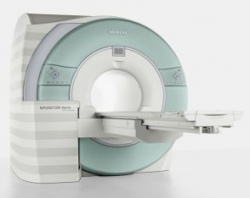MRI techniques to replace liver biopsy
As reported in the January issue of Hepatology, MRI imagery is emerging as a non-invasive way to determine the existence and extent of hepatic fibrosis. It could eventually help the development of pharmacologic strategies to combat the condition.

Currently, the best way to assess hepatic fibrosis is liver biopsy; however, it is an invasive procedure that can cause serious side effects. Researchers have been studying less invasive techniques, such as blood tests and imaging strategies like ultrasound, but so far, they have not proven sensitive enough to detect the various stages of fibrosis.
Over the past decade, a number of technological advances have been made in magnetic resonance (MR) imaging of the liver. Researchers led by Jayant Talwalkar of the Mayo Clinic, examined the current state of MR imaging and the studies that looked at its utility in detecting liver fibrosis.
They found that contrast-enhanced magnetic resonance imaging, magnetic resonance spectroscopy, and diffusion-weighted magnetic resonance imaging have shown promise for detecting hepatic fibrosis, though they require further refinement.
But the technology that is showing the greatest promise is magnetic resonance elastography, which quantitatively assesses tissue stiffness. Recent studies have shown that MR elastography has high sensitivity and specificity in detecting fibrosis stages. "As with other techniques, efforts to standardize the equipment and techniques used for MR elastography should be pursued to maximize diagnostic accuracy and facilitate comparison of results in different settings," the authors suggest. "Reproducibility appears good from initial studies but requires additional study for verification.".
The authors emphasize that the design and conduct of high-quality diagnostic accuracy studies is essential for ongoing validation of these emerging non-invasive techniques for determining hepatic fibrosis. Most relevant studies to date have included small numbers of patients and lacked independent assessment, issues that should be addressed in future studies.
Once MRI techniques have become suitably advanced, patients will likely prefer them to liver biopsy. "While the number of patients screened for hepatic fibrosis may increase using MR imaging, proof will be required that early detection and intervention can reduce morbidity and resource utilization associated with the clinical sequelae of advanced disease," the authors point out.
"The development of a reliable and valid non-invasive method to assess hepatic fibrosis could result in comparable or, perhaps, improved accuracy in terms of staging," they conclude. "The emergence of MR imaging techniques (singly or in combination with other methods) could result in the performance of true functional hepatic imaging."
Over the past decade, a number of technological advances have been made in magnetic resonance (MR) imaging of the liver. Researchers led by Jayant Talwalkar of the Mayo Clinic, examined the current state of MR imaging and the studies that looked at its utility in detecting liver fibrosis.
They found that contrast-enhanced magnetic resonance imaging, magnetic resonance spectroscopy, and diffusion-weighted magnetic resonance imaging have shown promise for detecting hepatic fibrosis, though they require further refinement.
But the technology that is showing the greatest promise is magnetic resonance elastography, which quantitatively assesses tissue stiffness. Recent studies have shown that MR elastography has high sensitivity and specificity in detecting fibrosis stages. "As with other techniques, efforts to standardize the equipment and techniques used for MR elastography should be pursued to maximize diagnostic accuracy and facilitate comparison of results in different settings," the authors suggest. "Reproducibility appears good from initial studies but requires additional study for verification.".
The authors emphasize that the design and conduct of high-quality diagnostic accuracy studies is essential for ongoing validation of these emerging non-invasive techniques for determining hepatic fibrosis. Most relevant studies to date have included small numbers of patients and lacked independent assessment, issues that should be addressed in future studies.
Once MRI techniques have become suitably advanced, patients will likely prefer them to liver biopsy. "While the number of patients screened for hepatic fibrosis may increase using MR imaging, proof will be required that early detection and intervention can reduce morbidity and resource utilization associated with the clinical sequelae of advanced disease," the authors point out.
"The development of a reliable and valid non-invasive method to assess hepatic fibrosis could result in comparable or, perhaps, improved accuracy in terms of staging," they conclude. "The emergence of MR imaging techniques (singly or in combination with other methods) could result in the performance of true functional hepatic imaging."
11.01.2008
More on the subject:











